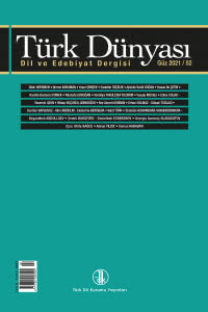ŞAMANİZM İNANCINDA RİTÜEL MASKELERİ VE GÖMÜ MASKELERİ
Maske tanınmamak, korunmak, gizlenmek ve güzel görünmek gibi farklı amaçlarla
Rituals and Burial Masks in Shamanism Belief
The masks are artificial faces and helmets made of different materials and put onface and head for the purposes such as protection, not being recognized, appearingbeautiful. The meaning and function of masks depend on the binding. And they arecategorized in two: ritual and burial masks. While ritual masks are made for livings,burial ones are made for deaths. Thanks to the scientific studies made in Siberia,Altai and especially in Yenisei region, a good number of masks, bust, puppet andmasks carved on the rocks as well as animal-figure drawings have been found. In thiscontext in rituals and ceremonies performed by the Shaman(Kam)to gain the mercy ofthe spirits and gods who govern nature and to be pleasant to them, the shaman, whogovern the ritual, wears the appropriate mask and helmet. It is known that the maskworn by Hakas or Yakut shamans in the ritual symbolizes the animal or entity to whichhe or she belongs.Masks called burials and busts were applied to the skulls of the large and finalburials made in a few years. Here are some purposes. Burial masks are to prevent anddisguise any deformation of the head of death, to deny surrendering to the death andto recognize bodies in huge burial. The body of the deceased person shall be kept intemporary place until the final burial by the family and community of which he is amember. Dummy-mannequins were built as a place to find the spiritual soul of the deceased,and the ashes of the burnt corpse were placed in this puppet. The burial masksand bustings were made of plaster stone clay in general; the burial mannequins wereprepared from animal skins. The society tries its best to prepare the deaths for theultimate burial and does not cease its spiritual contact with the past, which has theirown cultural memory. The spiritual bond with which the people are trying to protectis the foundation of their future.
___
- ASSMAN, Jan (2015), Kültürel Bellek, (Çeviren: Ayşe Tekin), Ayrıntı Yayınları, İstanbul.
- BİÇURİN, Nikita Yakovleviç (1851), “Sobranie Svedeniy O Narodah Obitavşih v Sredney Azii v Drevnie Vremena”, http://www.vostlit.info/Texts/Dokument / u/China/ Biçurinht, SSCB, Moskova-Leningrad, 1950, 2001, 2005.
- ÇOBANOĞLU, Özkul (2001), “Anonim Sözlü Edebiyatı”, Türk Dünyası Edebiyat Tarihi, C 1, s. 5-444, Atatürk Yüksek Kurumu Atatürk Kültür Merkezi Yayını, Ankara.
- KAPTAN, Özgür (1997), İç Mekânda Seramik Maskelerin Mekâna Bağlı Yardımcı Malzemeler ile Uygulanması, (Anadolu Üniversitesi Sosyal Bilimler Enstitüsü, basılmamış Yüksek Lisans Tezi), Eskişehir.
- KAPTAN, Özgür, Maske Geleneği // https://earsiv.anadolu.edu.tr (Erişim 15.02.2017).
- KATANOV, Nikolay Fyodoroviç (2004), Türk Kabileleri Arasında // Merkez ve Doğu Asya Türk Kabilelerinde Gömü Gelenekleri, (Çeviren: Atilla Bağcı ), Kömen Yayınları, Konya.
- POTANİN, G. N. (1881-1883), Oçerki Severo-Zapadnoy Mongolii: Rezultatı Puteşestviiy, İspolnennıh v 1876-18777, 1879-1880 gg. Po Poruçenii İmp. Russk. Geog. Ob-va., Sankt-Peterburg, s. 53.
- PROKOFYEVA, Yekaterina Dmitriyevna (2014), “Şamanskiye Kostümı Narodov Sibiri”, (Çeviren: Atilla Bağcı), TKAE, Ankara.
- RAGLAN, Lord (2005), “Mit ve Ritüel”, (Çeviren: Evrim Ölçer Özünel), Halkbiliminde Kuramlar ve Yaklaşımlar, C. 2, s. 318-331, Geleneksel Yayıncılık, Ankara.
- RAPPAPORT, Roy A. (2006), “Ritüel”, (Çeviren: Kürşat Korkmaz), Halkbiliminde Kuramlar ve Yaklaşımlar, C. 1, s. 299-308, Geleneksel Yayıncılık, Ankara.
- SEGAL, A. Rober (2014), “Dinsel Mit-Ritüel Kuramı”, (Çeviren: Naim Atabağsoy), Halkbiliminde Kuramlar ve Yaklaşımlar, C. 4, s. 271-284, Geleneksel Yayıncılık, Ankara.
- TOPUZ, Hıfzı (1992), Kara Afrika Sanatı, Anadolu Matbaası, İstanbul.
- VADETSKAYA, Elga Borisovna (2009), Drevnie Maski Yeniseya, Krasnoyarsk – St.Petersburg.
- VADETSKAYA, Elga Borisovna (2014), Sibirya Kurganları, (Çeviren: Atilla Bağcı), TKAE, Ankara.
- ISSN: 1301-0077
- Yayın Aralığı: Yılda 2 Sayı
- Başlangıç: 1996
- Yayıncı: Türk Dil Kurumu
Sayıdaki Diğer Makaleler
SÜHEYL Ü NEVBAHÂR’DA deg-, degür- FİİLLERİ ve +A degir / degmez SÖZ KALIBININ ANLAŞILMASI SORUNU
TÜRK DÜNYASININ İKİ ‘GÖL ŞAİRİ’ HAŞİM VE ALIKUL
MİTOLOJİLERDE VE TÜRK DESTANLARINDA KÖPÜK
KAZAK DİLİNDEKİ DEYİMLERİN KULLANIM ÖZELLİKLERİ
DİVÂN-I HİKMET’TE ATASÖZLERİ VE KULLANILIŞ ÖZELLİKLERİ
DÜNYA NASREDDIN HOCA FIKRA KÜLLIYATI 1616’YA YÜKSELDI
DİVANU LÛGATİ’T-TÜRK’TE ANLAMI PROBLEMLİ BAZI CÜMLELER VE SÖZCÜKLER
